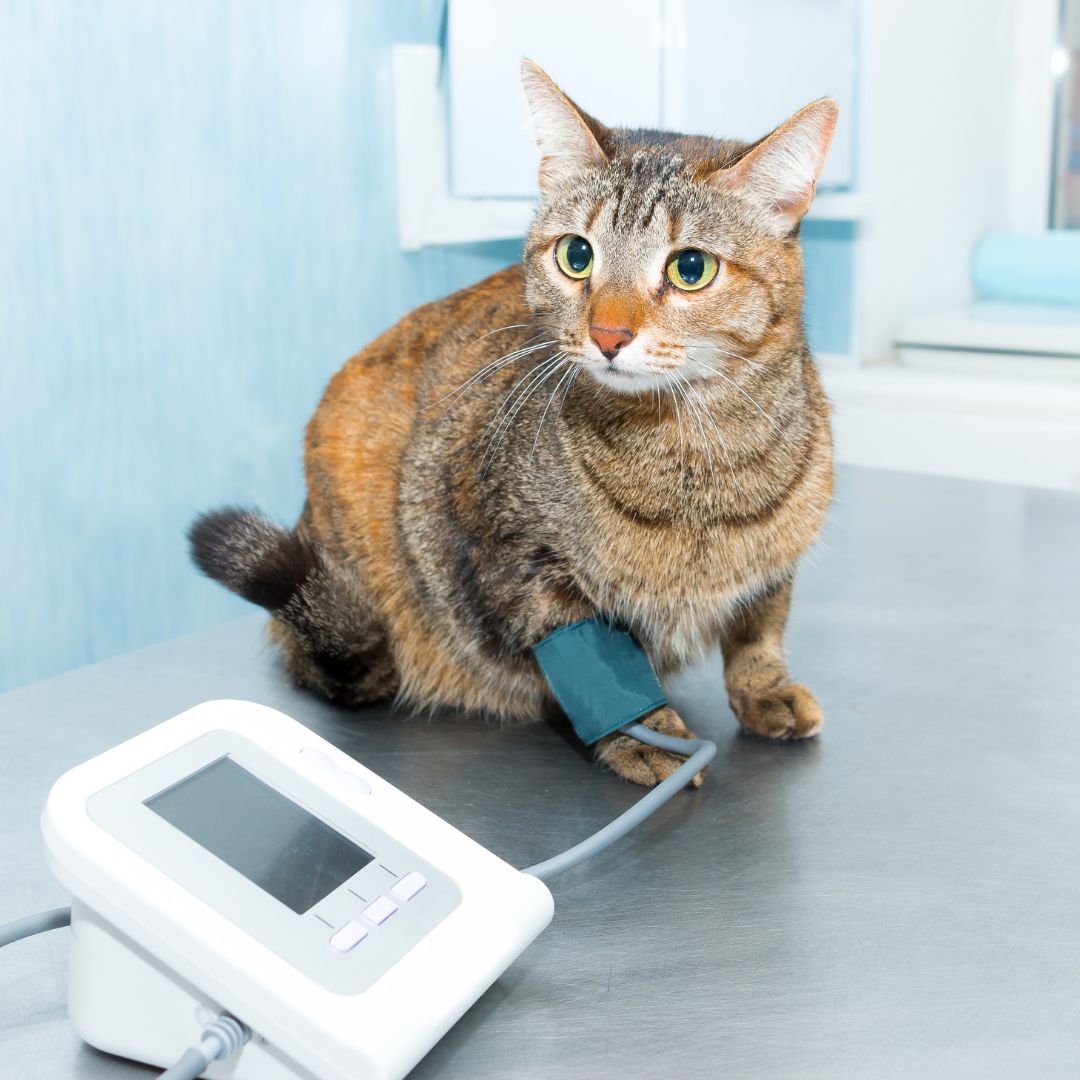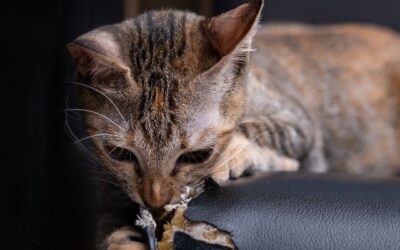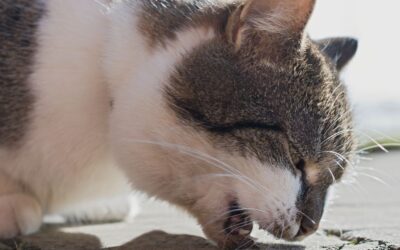Hypertension or high blood pressure is a common health condition in cats. If untreated, it can result in numerous health issues. It is defined as a prolonged elevation of blood pressure levels over the normal range. Unfortunately, high blood pressure in cats is frequently misdiagnosed or neglected, which is a major concern for both cat parents and vets. You may prevent hypertension in your feline buddy by having regular check-ups with your veterinarian, maintaining a balanced diet, exercising frequently, and managing stress in cats.
This article examines the signs, causes, consequences, treatment, and prognosis of high blood pressure in cats while offering tips on preventing and treating it.
Symptoms of High Blood Pressure in Cats
Although the symptoms of high blood pressure in cats are not always obvious, some typical warning signals to watch out for include:
Vision Abnormalities. Sudden Blindness
Cats with high blood pressure may experience vision abnormalities like blood within the chamber of the eye, retinal damage, dilated pupils that do not constrict with light, and often sudden blindness. Small blood vessels in the retina are damaged by high blood pressure, which results in less blood flow and oxygen supply to the retina. Blindness may arise from a retinal detachment or hemorrhage.
Seizures
Due to reduced blood flow and oxygen supply to the brain, high blood pressure in cats can result in seizures. Neurological symptoms like tremors, confusion, and seizures may develop from this. Seizures can jeopardize a cat’s life in extreme circumstances.
Vomiting
High blood pressure in cats can lead to nausea, vomiting, and decreased appetite. These signs can cause cats to become malnourished and dehydrated, which can exacerbate the illness.
Thirst and Frequent Urination
High blood pressure might make your cat thirstier and urinate more frequently. This may be the result of hypertension-related renal injury. The body’s fluid and electrolyte balance is critically regulated by the kidneys. The inability of damaged kidneys to efficiently control the water balance causes excessive thirst and urine.
Nosebleeds
Small blood vessels in the nose might burst as a result of high blood pressure, later resulting in nosebleeds. This may indicate serious hypertension and calls for prompt veterinarian care.
Behavioral Changes
Cats with high blood pressure may exhibit more irritability or lethargy than usual. Cats with high blood pressure may experience pain and discomfort, which may modify their behaviors. Due to the discomfort brought on by hypertension, cats may appear lethargic, despondent, or angry. It’s important to get veterinary care if you detect behavioral changes in your cat because these may also be symptoms of other underlying medical concerns.
Causes of Hypertension or High Blood Pressure in Cats
Other variables can contribute to feline hypertension in addition to the well-known underlying medical disorders such as renal disease, hyperthyroidism, and heart disease. Here are a few examples:
Obesity
Just like in humans, overweight cats are more likely to develop high blood pressure. Hormones produced by fat tissue have the potential to tighten blood arteries and raise blood pressure.
Diabetes
Cats who have diabetes are more likely to acquire blood pressure problems. This is due to the fact that diabetes has the potential to harm blood vessels and have an impact on the body’s capacity to control blood pressure.
Cushing’s Disease
Cats with Cushing’s disease may have high blood pressure because it is a hormonal illness. The overproduction of cortisol, a stress hormone that can raise blood pressure, is what causes this illness.
Certain Drugs
As a side effect, some drugs meant to treat various medical disorders can also cause high blood pressure in cats. For instance, prolonged usage of steroids in cats is known to result in elevated blood pressure.
Polycythemia
Polycythemia is a condition when the body produces more red blood cells than normal. High blood pressure may result from the thickening of the blood, which makes the heart work harder to pump.
Obstructive Sleep Apnea
This condition causes breathing to stop repeatedly while you sleep, which lowers your blood oxygen levels and raises your blood pressure. Both cats and humans can have this ailment.
Effects of High Blood Pressure in Cats
Keep in mind that feline hypertension can aggravate existing medical disorders such kidney disease, hyperthyroidism, and heart disease.
Kidney Damage
High blood pressure in cats can harm their kidneys’ minuscule blood arteries, which can result in diminished renal function or even kidney failure. The body’s fluid balance is controlled by the kidneys, which also filter waste from the blood. If neglected, feline hypertension can result in chronic kidney disease, an irreversible injury to the kidneys.
Heart Diseases
By harming the heart and blood arteries, high blood pressure can raise the risk of heart disease in cats. Blood pressure and heart rate rises as a result of the heart working harder to pump blood through congested, restricted blood arteries. This can result in the heart muscles thickening and deteriorating over time, eventually leading to heart failure.
Hyperthyroidism
Hyperthyroidism is brought on by the thyroid gland, which is found in cats’ necks and overproduces thyroid hormones. The regulation of blood pressure can be impacted by the overproduction of certain hormones in the body. The amount of blood that the heart pumps per minute can rise in hyperthyroid cats as a result of the extra thyroid hormone. A rise in blood pressure may result from this increased cardiac output. A decrease in peripheral resistance, or the resistance to blood flow in the arteries, is another effect of high thyroid hormone. Blood pressure levels may rise as a result of the decline in peripheral resistance.
Approximately 25% of cats with hyperthyroidism have high blood pressure. Cats with hyperthyroidism are more likely to develop hypertension, which, if ignored, can lead to a number of health issues. Cats with hyperthyroidism require regular blood pressure monitoring and quick hypertension treatment to avoid developing further medical issues.
Tips to Prevent Hypertension on High Blood Pressure in Cats
Prevention is always better than cure! Here’s what you can do to control your cat buddy’s blood pressure:
Regular Check-Ups
Keeping your cat healthy overall and identifying any underlying medical concerns, like hypertension, require regular check-ups with your veterinarian. Your cat’s blood pressure will be checked regularly by your veterinarian, who will also search for any indications of hypertension. Early diagnosis and treatment can stop hypertension from developing into a serious medical condition.
Healthy Diet
It’s important to maintain a healthy diet for cats to avoid high blood pressure issues. Avoid giving your cat meals that are heavy in sodium or salt because doing so can raise blood pressure. Choose a diet high in omega-3 fatty acids, antioxidants, and other necessary nutrients. These minerals can improve your cat’s general health by regulating blood pressure levels. Choose cat food that is high in protein and low in carbohydrates, which can help regulate your cat’s metabolism.
Regular Exercise
Exercise is vital for lowering stress, which can help cats’ blood pressure levels stay in check. Encourage your cat to play with interactive toys or indulge in other frequent physical activities. Maintaining a healthy weight is essential for preventing hypertension in cats, and exercise can help with that.
Stress Management
Stress is a common contributor to the problem of high blood pressure in cats, which can be avoided by lowering stress levels. Make sure your cat has a cozy and secure habitat with places to hide, scratching posts, and soft bedding. Play and engage in activities your cat enjoys when you two are together. This can lower stress levels and blood pressure.
Remember that preventative strategies should be customized to the particular requirements and medical issues of your cat. Here are 10 Powerful Suggestions from a Veterinarian to Keep Your Cat Healthy. If you wish to develop a personalized plan for preventing feline hypertension, speak with your veterinarian.
Early diagnosis and treatment are essential to halt the progression of hypertension and the consequences it causes. It’s important to seek veterinary care right away if you observe any signs of hypertension in your cat, such as lethargy, increased thirst, urination, vomiting, or nosebleeds.
By staying informed about hypertension and taking proactive steps to prevent and manage the condition, cat parents can ensure their feline friends live long, healthy lives.





0 Comments